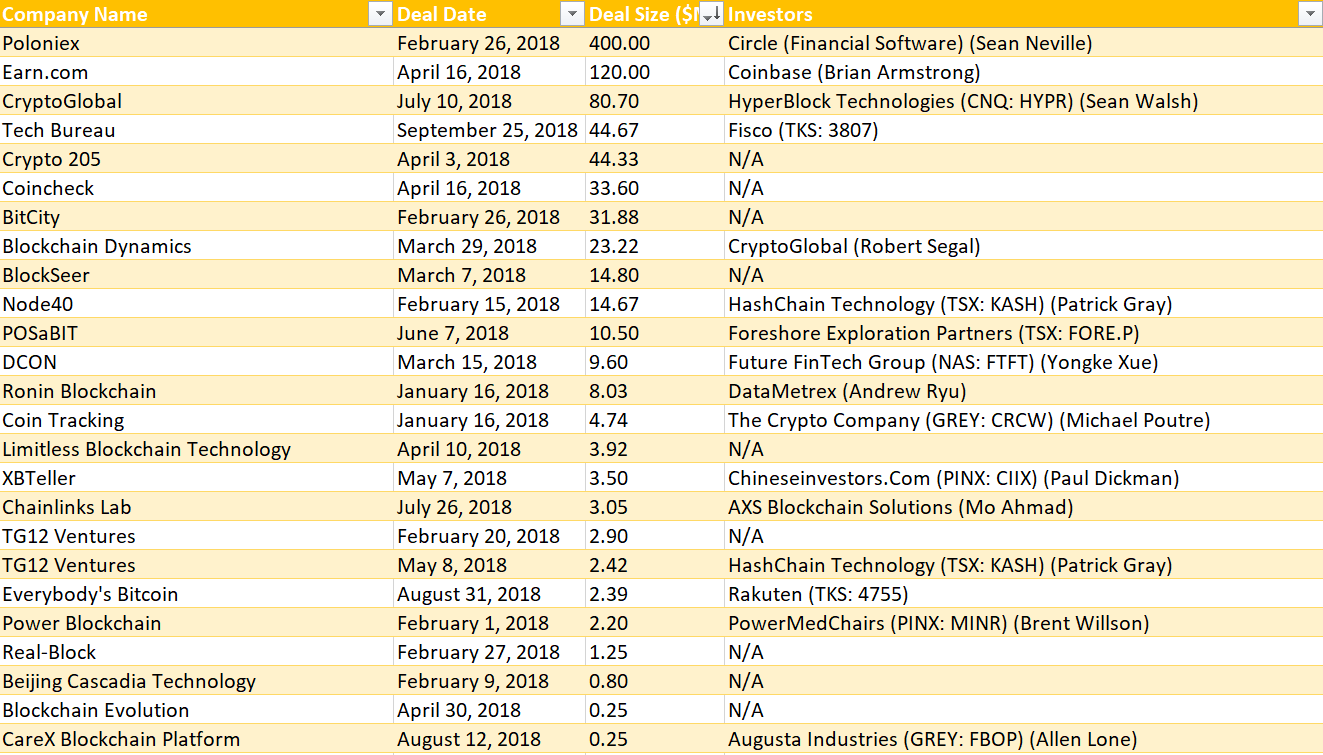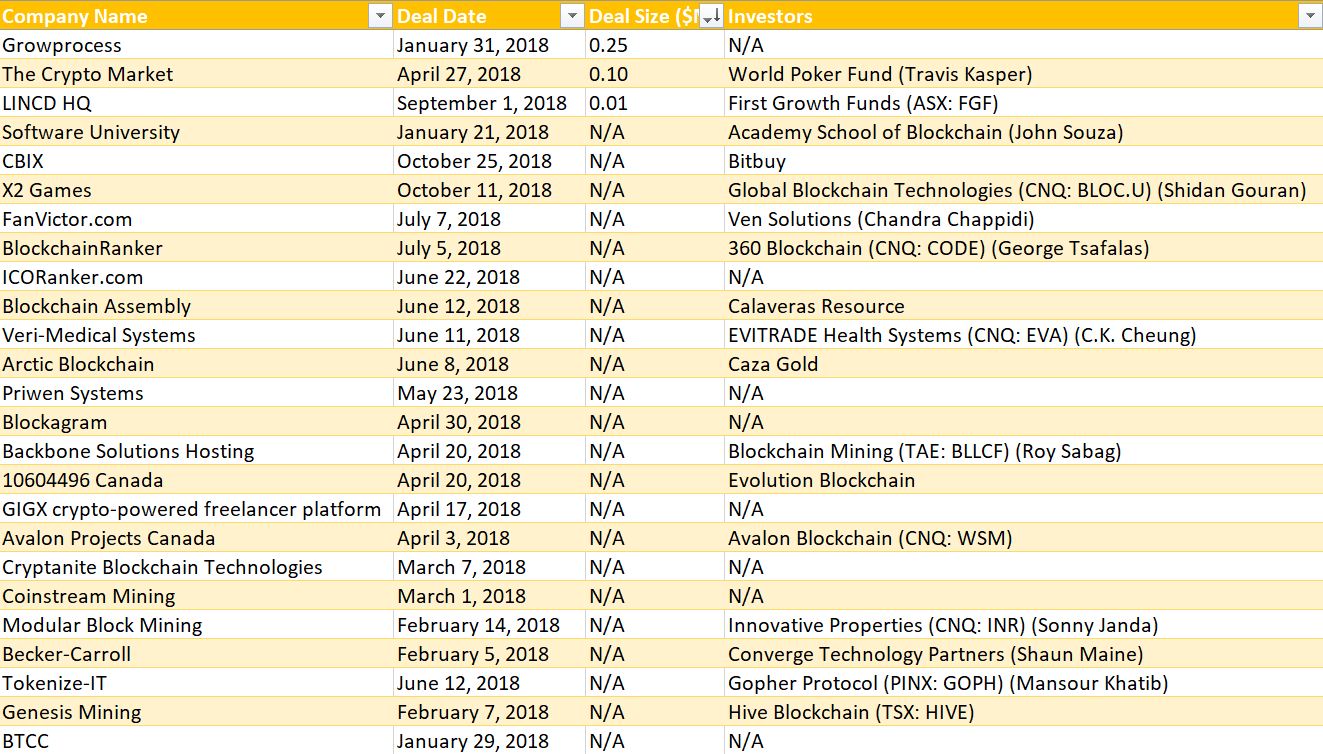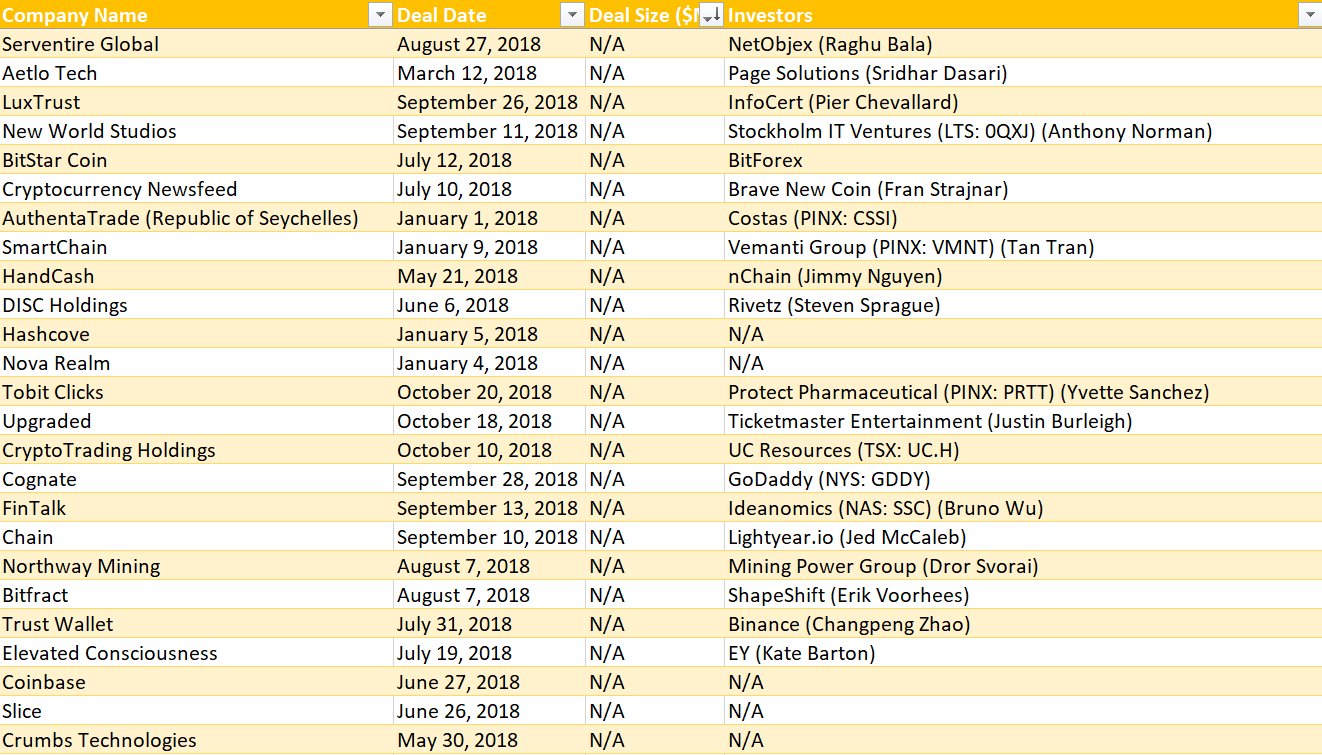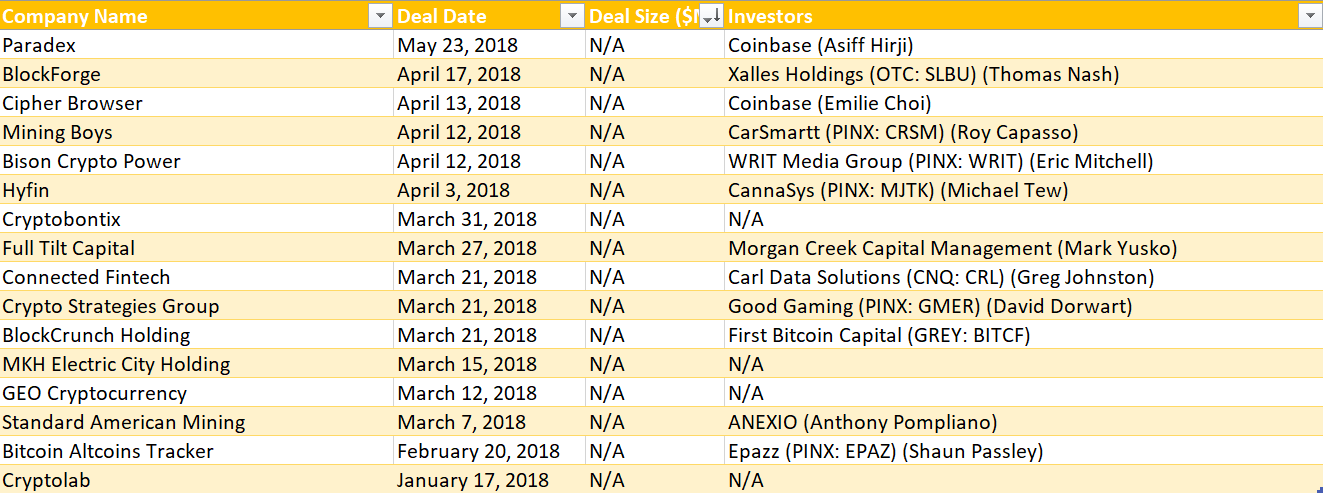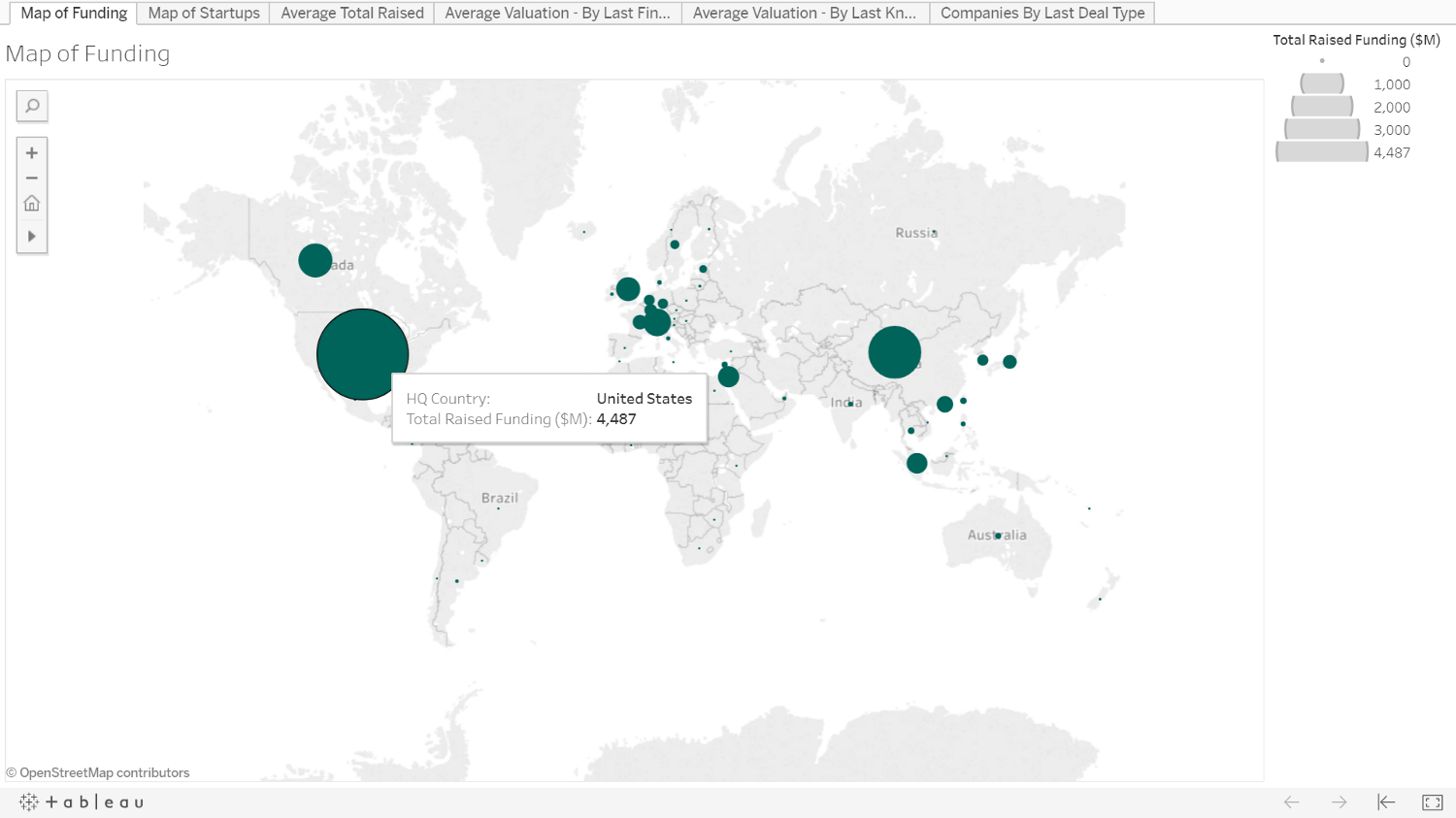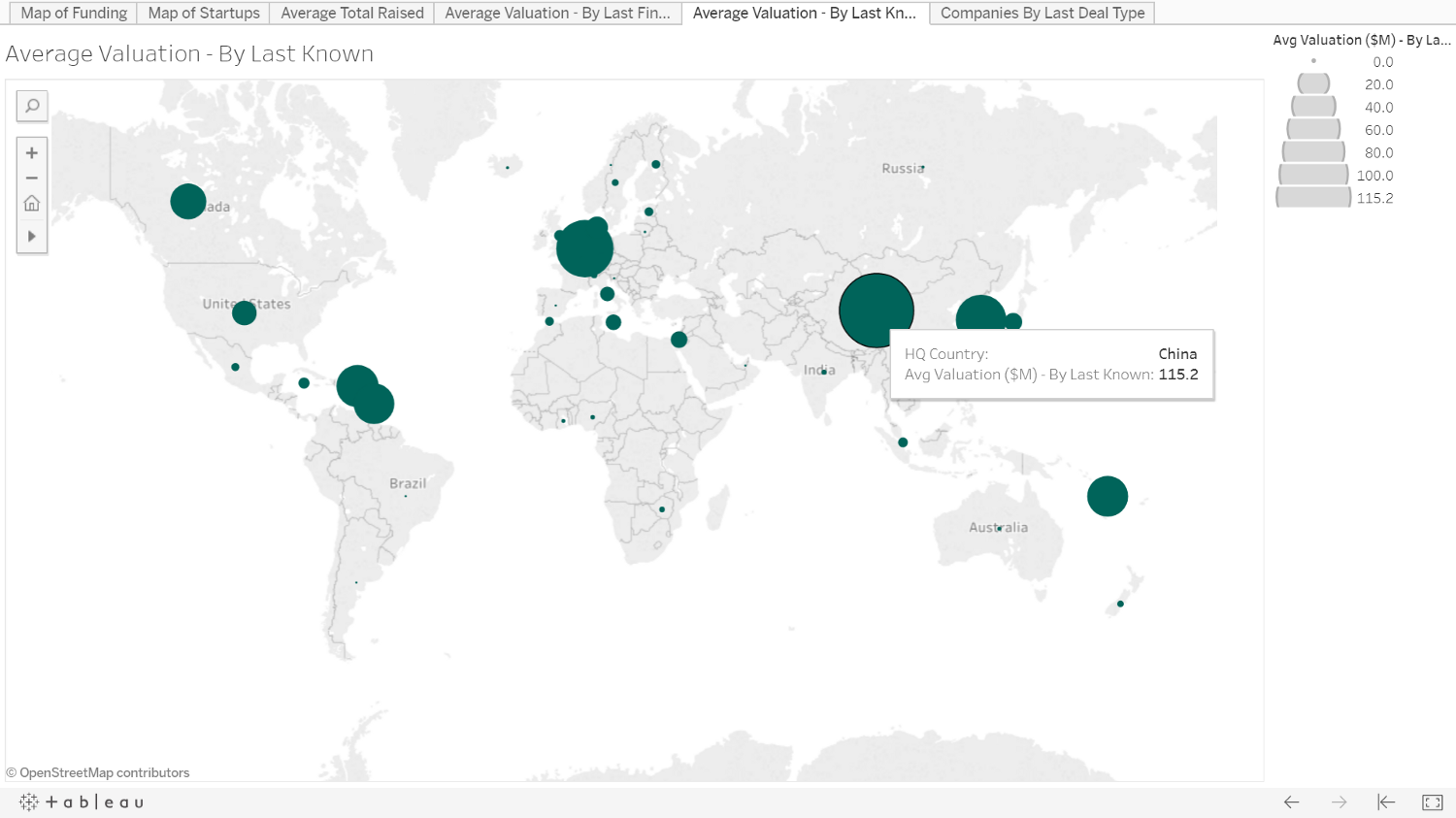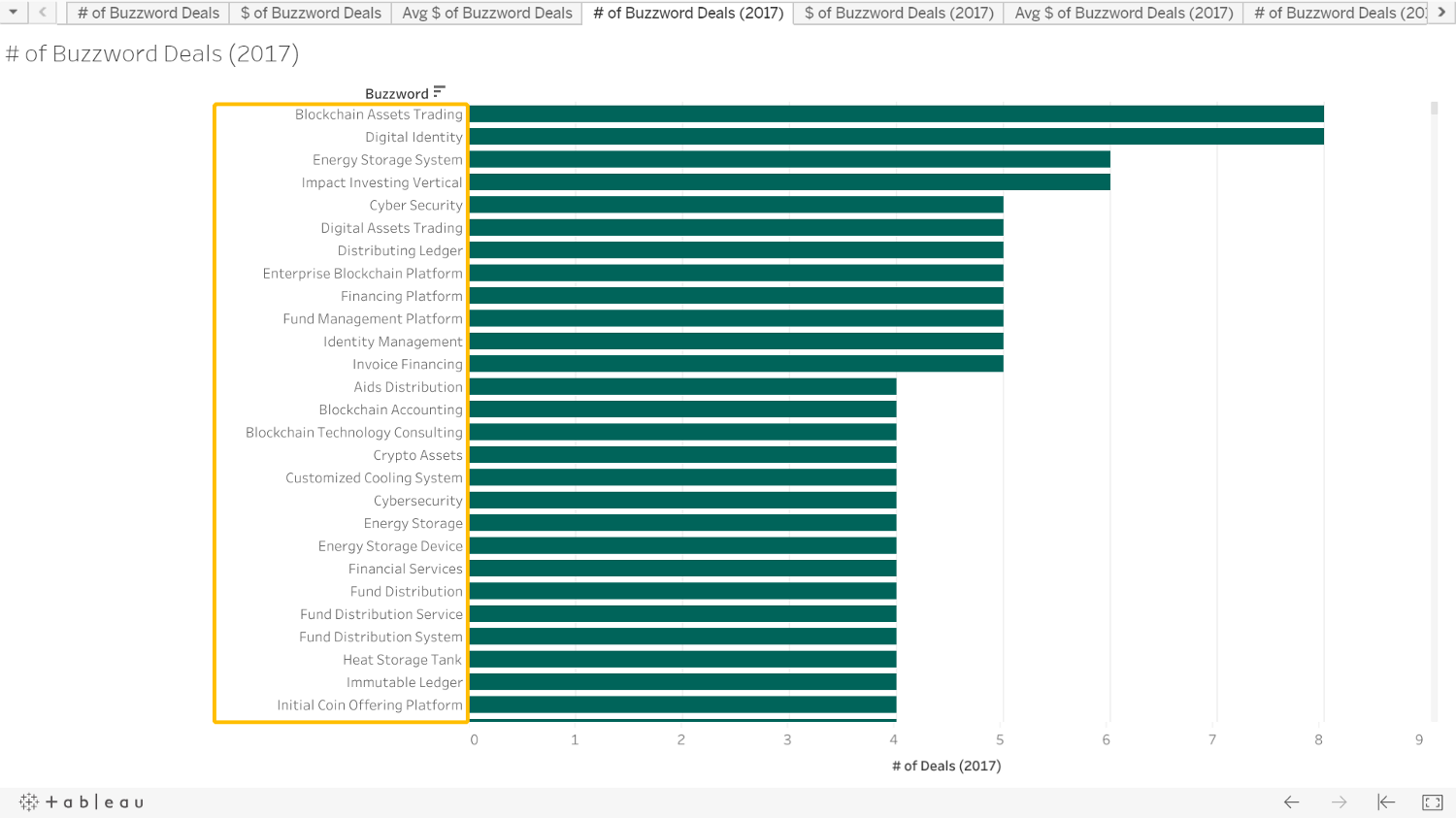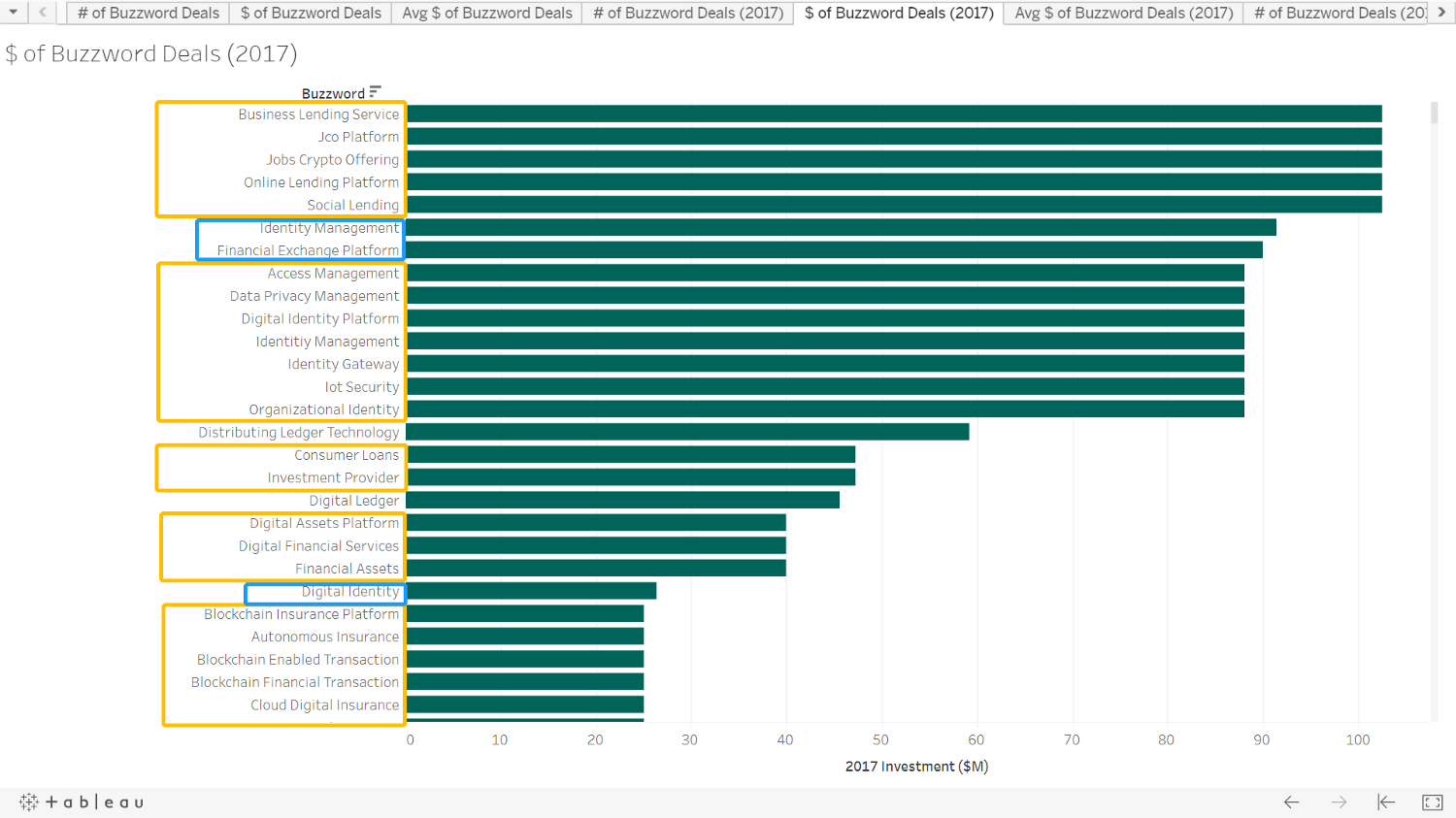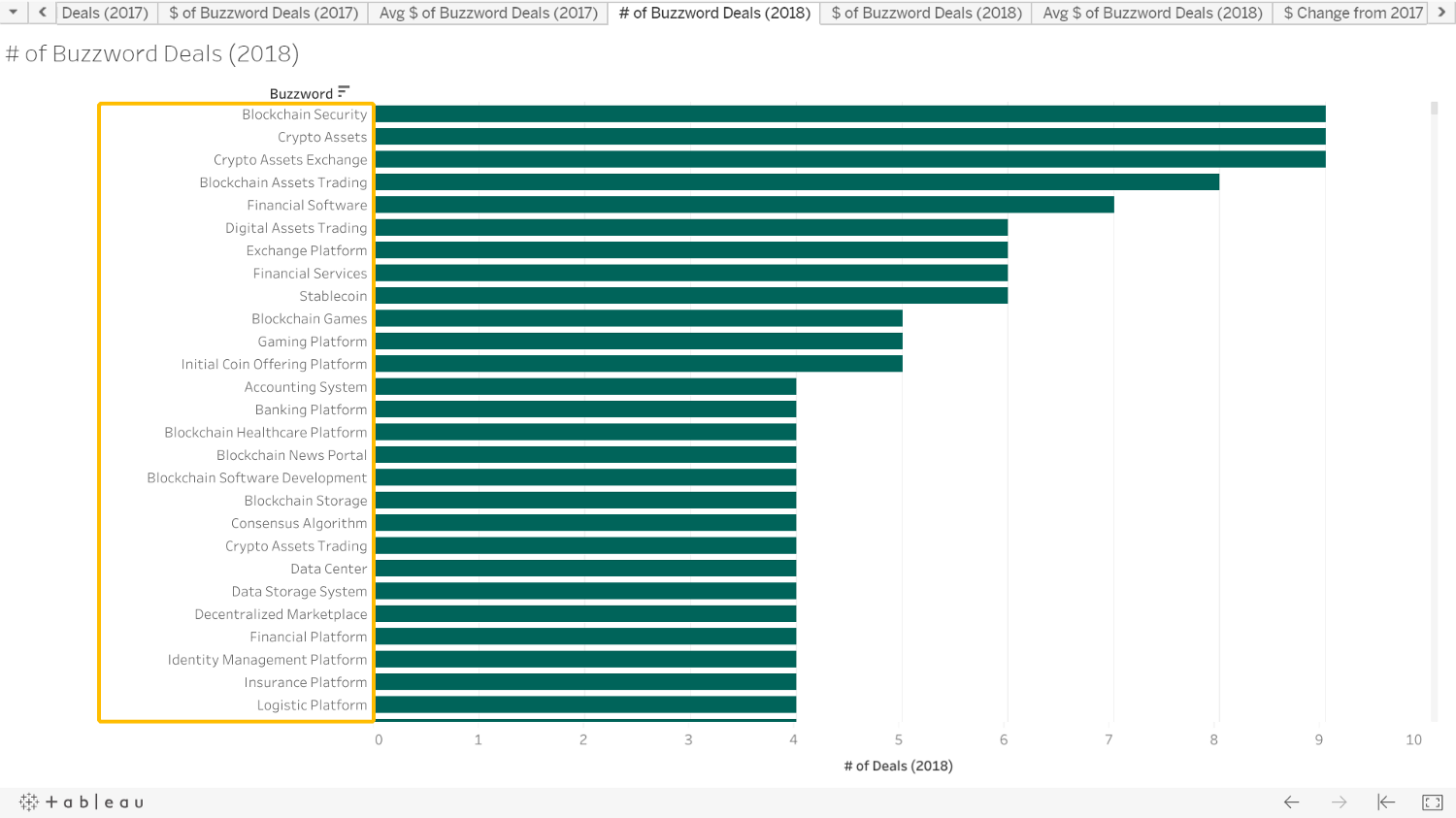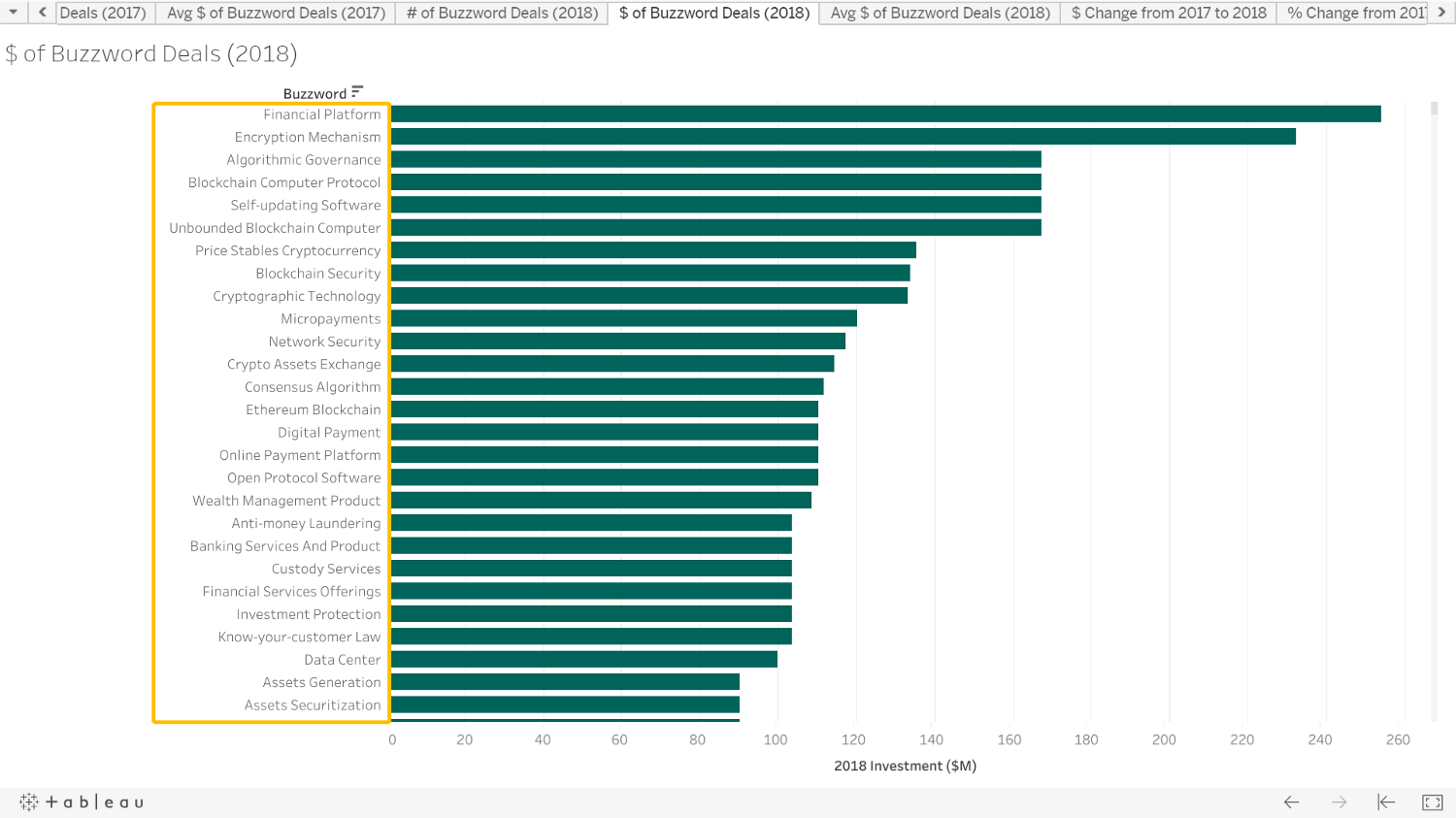tl;dr
Summary
It has been a question for me for a while: where are the VCs investing into in the blockchain space? After this quantitative examination on 2,288 blockchain-related companies and 3,036 deals about these companies, it is clear that most VCs are still simply investing in cryptocurrency-related start-ups, since this is the relatively easiest/safest way to make money. However, VCs are also starting to look into the new cryptographic technologies and protocol designs, since it is still at the very early stage of blockchain and a better protocol is needed.
Please feel free to click the link below images to see the interactive version of diagrams (or click here). All data comes from PitchBook.
Market
Most funding has been directed to companies in the US and China.
Geographically, most of the funding ($8,869 M) has been raised in the United States ($4,487 M), China ($1,512 M, excluding the Bitman IPO), and Canada ($628 M). Following these three markets, United Kingdom, Switzerland, Israel, Singapore, South Korea, Japan, and Hong Kong have also attracted a notable volume of capital.
As of October 2018, the US market has 933 blockchain start-ups that have raised $4,487 M, while China has only 61 companies that have raised $1,512 M. However, companies headquartered in China have a higher average valuation ($115.2 M) than companies in the US ($12.6 M).
In terms of total raised funding, the Chinese companies also receive more money than companies in other countries. On average, the Chinese blockchain start-ups have raised $24.79 M, while the number is $4.81 M for US companies.
Therefore, it is obvious that there is a larger bubble as well as a higher capital concentration in China. To certain extent, this makes sense to me: most of the Chinese blockchain start-ups are cryptocurrency (issuance, trading, mining, etc.) companies that are actively targeting the Chinese residents. It is not difficult for them to sell the trash coins to millions of Chinese residents since (1) Chinese Yuan has been depreciating for a while and is expected to keep depreciating; (2) Chinese stock market has been a mess for a long time due to inappropriate management and lack of transparency; (3) Chinese residents lack alternative investment channels.
Investment is doubling in this space, regardless of the weird performance of cryptocurrency market.
Though the total market cap of cryptocurrencies has dropped dramatically in 2018, the number of blockchain deals has almost doubled from 2017. As of October 27, 2018, 918 deals have been made in this year, while only 547 deals were closed in 2017.
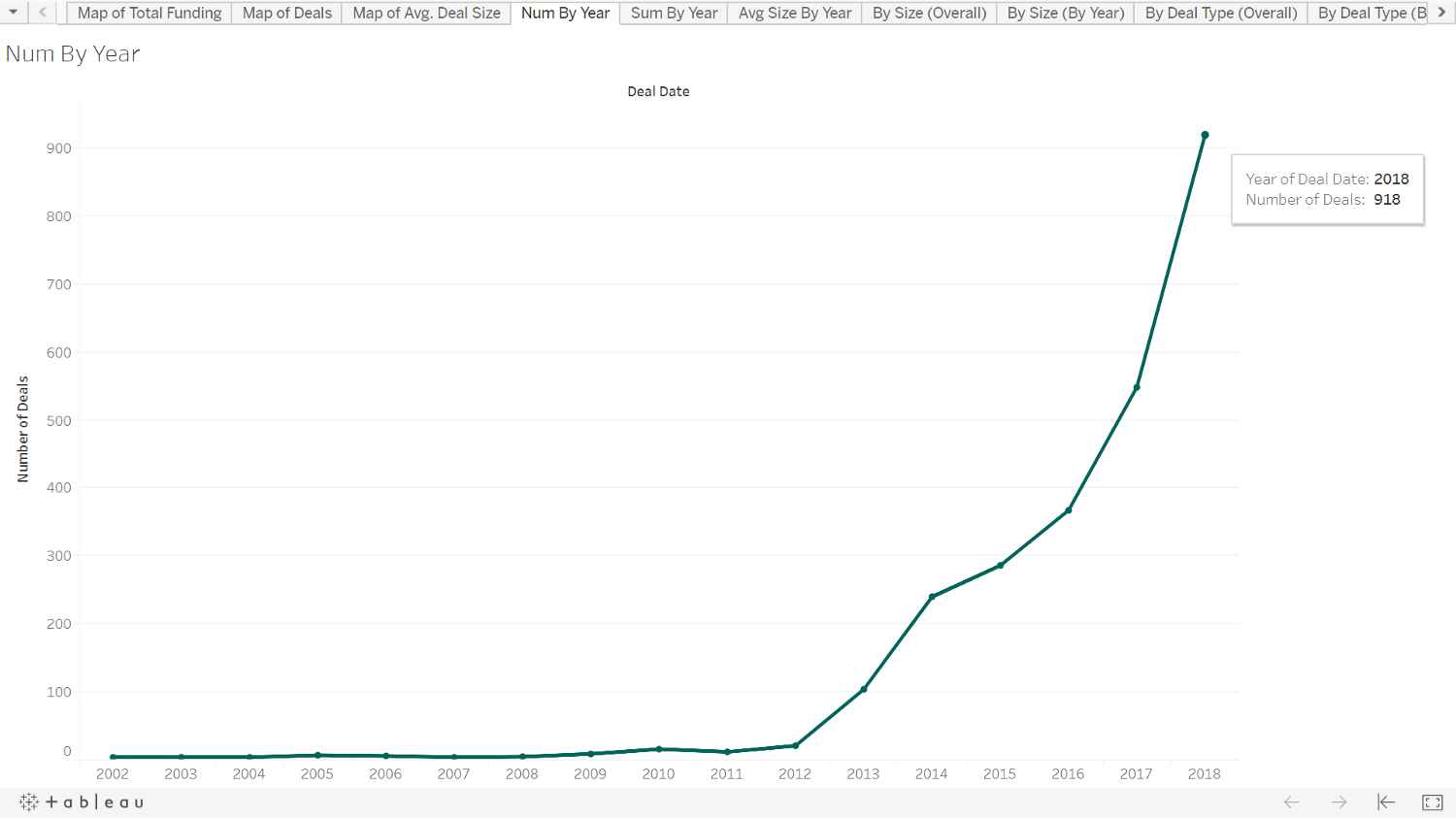
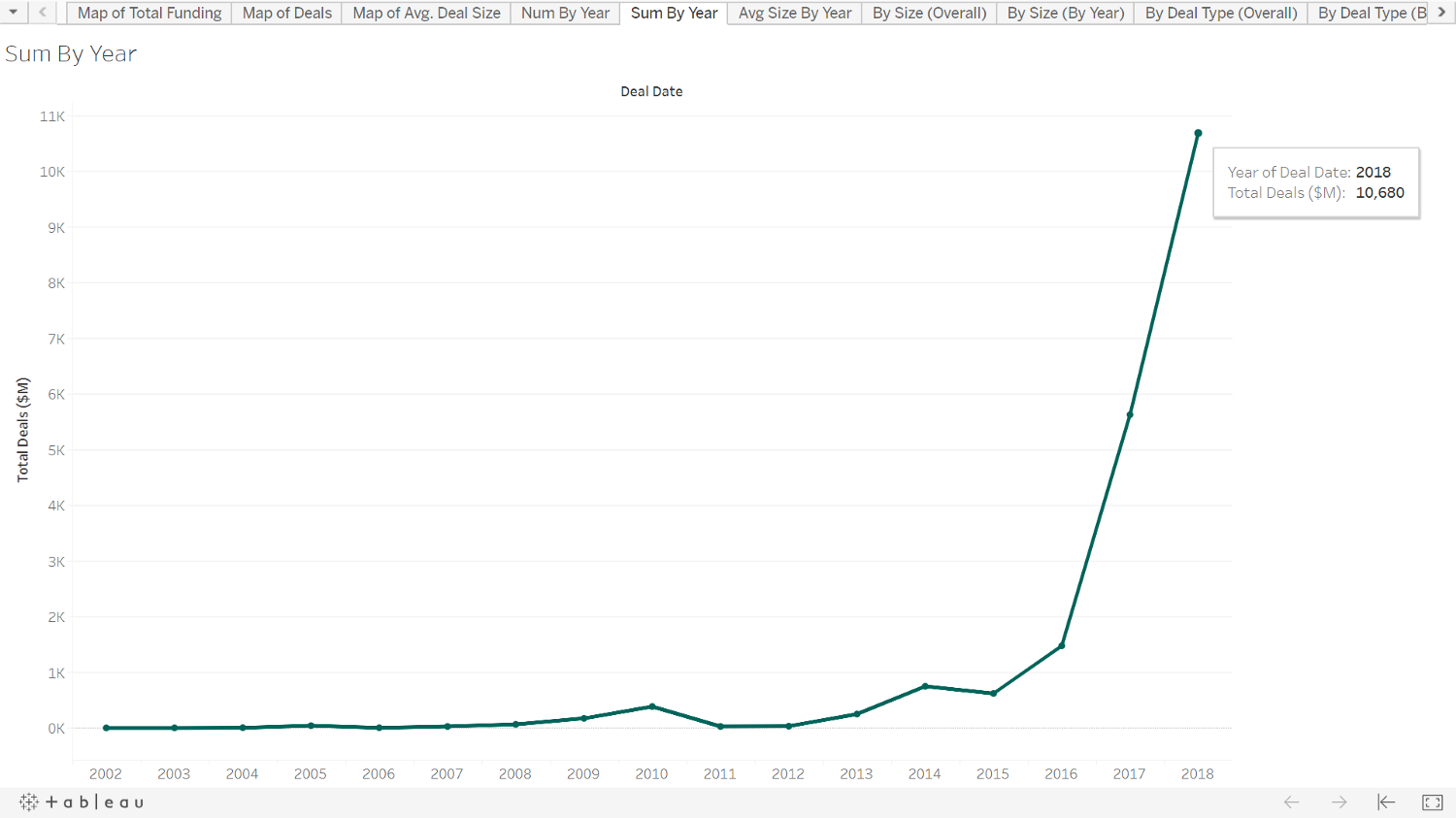
The total funding in 2018 has also doubled from 2017. As of October 27, 2018, $10,680 M have been raised (including ongoing IPOs), while only $5,623 M were collected in 2017.
Moreover, deals have become bigger in 2018. The $50+M and $10–50 M categories have been growing the most rapidly. 9 deals with $50+M investments happened in 2017, while 30 such deals have been made so far in 2018. The number of deals sized between $10 M to $50 M has tripled from 26 in 2017 to 89 in 2018 (As of October 27).
The rapid and stable growth of investments in blockchain start-ups indicates that the market did not lose its confidence about this technology due to the dramatic change in cryptocurrency market.
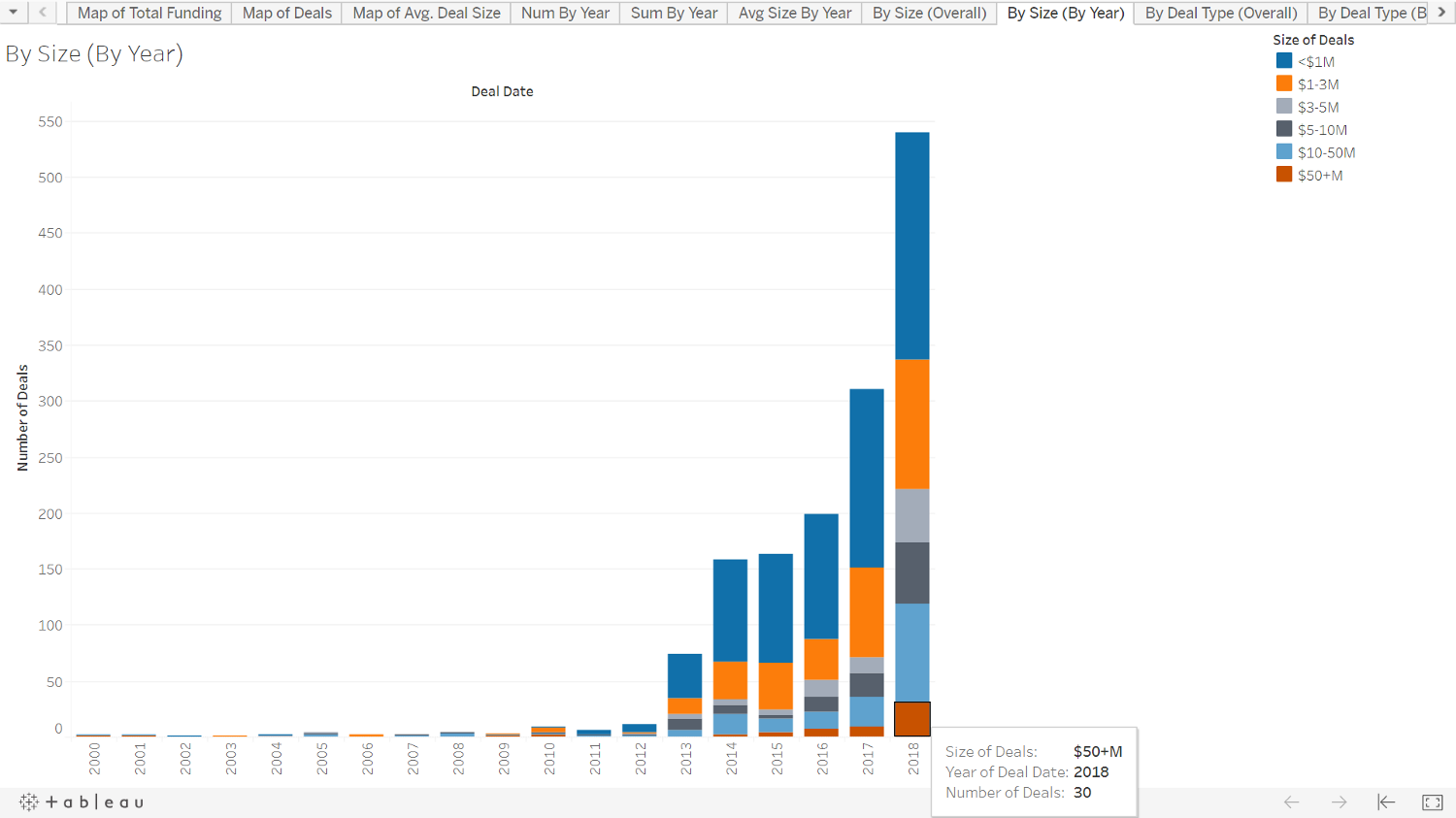
Investors
There are two types of investors in the blockchain space. One is the traditional VCs, such as IDG Capital and GV, that do not exclusively invest in blockchain but spend their money on all emerging technologies. The other type is the blockchain-dedicated VCs, such as Digital Currency Group and Fenbushi Capital, that are exclusively investing in blockchain projects. According to the deal data, most of the active investors (in terms of number of deals) are the blockchain-dedicated VCs.
It is not difficult to understand why a lot of deals are made by the new and dedicated VCs, since (1) there is a high knowledge barrier in understanding the blockchain technology and its applications; (2) an ecosystem/network is needed to develop and implement the technology.
Here is a list of the most active blockchain investors based on number of deals from 2002 to 2018:
Digital Currency Group (75), Blockchain Capital (50), Pantera Capital (41), Digital Currency Group (Barry Silbert) (33), Boost VC (30), Fenbushi Capital (30), Plug and Play Tech Center (29), Hashed (Accelerator) (27), Individual Investor (25), NEO Global Capital (24), 500 Startups (23), Danhua Capital (21), Y Combinator (19), SV Angel (17), Naval Ravikant (Naval Ravikant) (17), Future\Perfect Ventures (Jalak Jobanputra) (15), Andreessen Horowitz (15), Timothy Draper (Timothy Draper) (14), Barry Silbert (Barry Silbert) (14), FundersClub (14), Roger Ver (Roger Ver) (13), Draper Dragon (12), Techstars (12), Kindred Ventures (12), Bitmain (12), Fred Ehrsam (Fred Ehrsam) (12), Liberty City Ventures (11), ZMT Capital (10), Digital Finance Group (10), FBG Capital (10), ZhenFund (10), Paul Veradittakit (Paul Veradittakit) (9), IDG Capital (9), Union Square Ventures (9), GV (9), Abstract Ventures (9), RRE Ventures (James Robinson) (9), RRE Ventures (9), INBlockchain (9), FinForge (8), Hard Yaka (8), ConsenSys Tachyon (Kavita Gupta) (8), Draper Associates (Timothy Draper) (8), Coinbase (8), Ribbit Capital (Meyer Malka) (8), LINKVC (8), Lightspeed Venture Partners (Jeremy Liew) (8), Barclays Accelerator (8), Ceyuan Ventures (8), Ben Davenport (Ben Davenport) (8), Sean Percival (Sean Percival) (8), Node Capital (8), Elad Gil (Elad Gil) (8), Startupbootcamp (8), Block VC (8), Slow Ventures (8), AME Cloud Ventures (8).
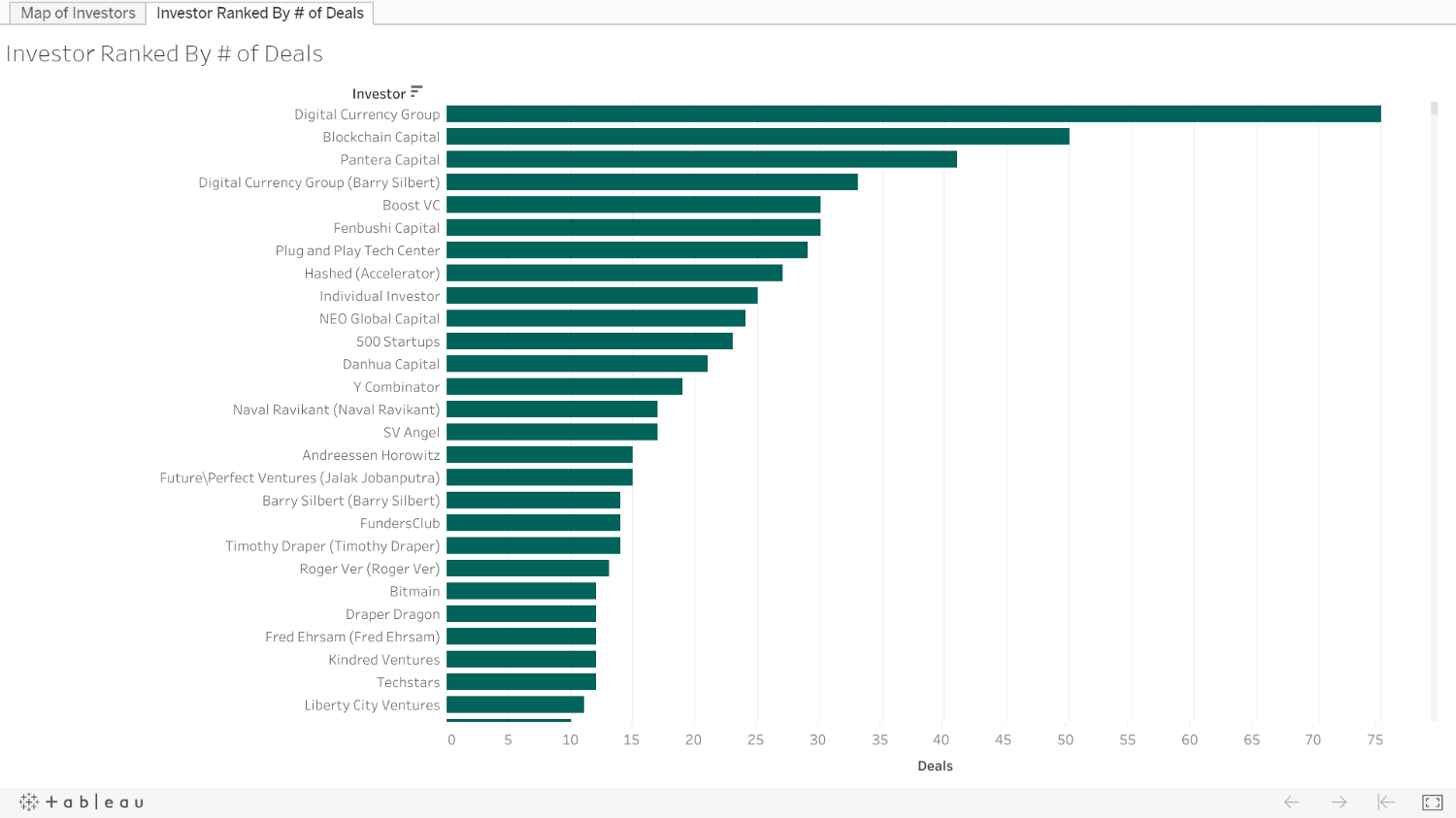
Deals
As of October 2018, most of the deals happened in the US (1,330 deals) with an average size of $5.04 M, followed by UK (269 deals/Average $2.37 M) and Canada (224 deals/Average $20.09 M). Unexpectedly, China has recorded only 94 deals while with the highest average deal size ($70.31 M), which further proves the concentration.
Almost 3/4 of the deals are early stage investments in the blockchain space. Out of the 3,035 recorded deals, 2,271 (74.83%) deals are early stage investment (Angel/Early Stage VC/Seed Round/Grant/Accelerator/Incubator). In 2018, the number of Early Stage VC deals doubles from 92 (2017) to 205 (2018). The numbers of Seed Round investment and Angel also increase a lot from 77 (2017) to 131(2018) and from 47 (2017) to 112 (2018) respectively. However, the number of Later Stage VC investment has dropped slightly from 11 (2017) to 9 (2018).
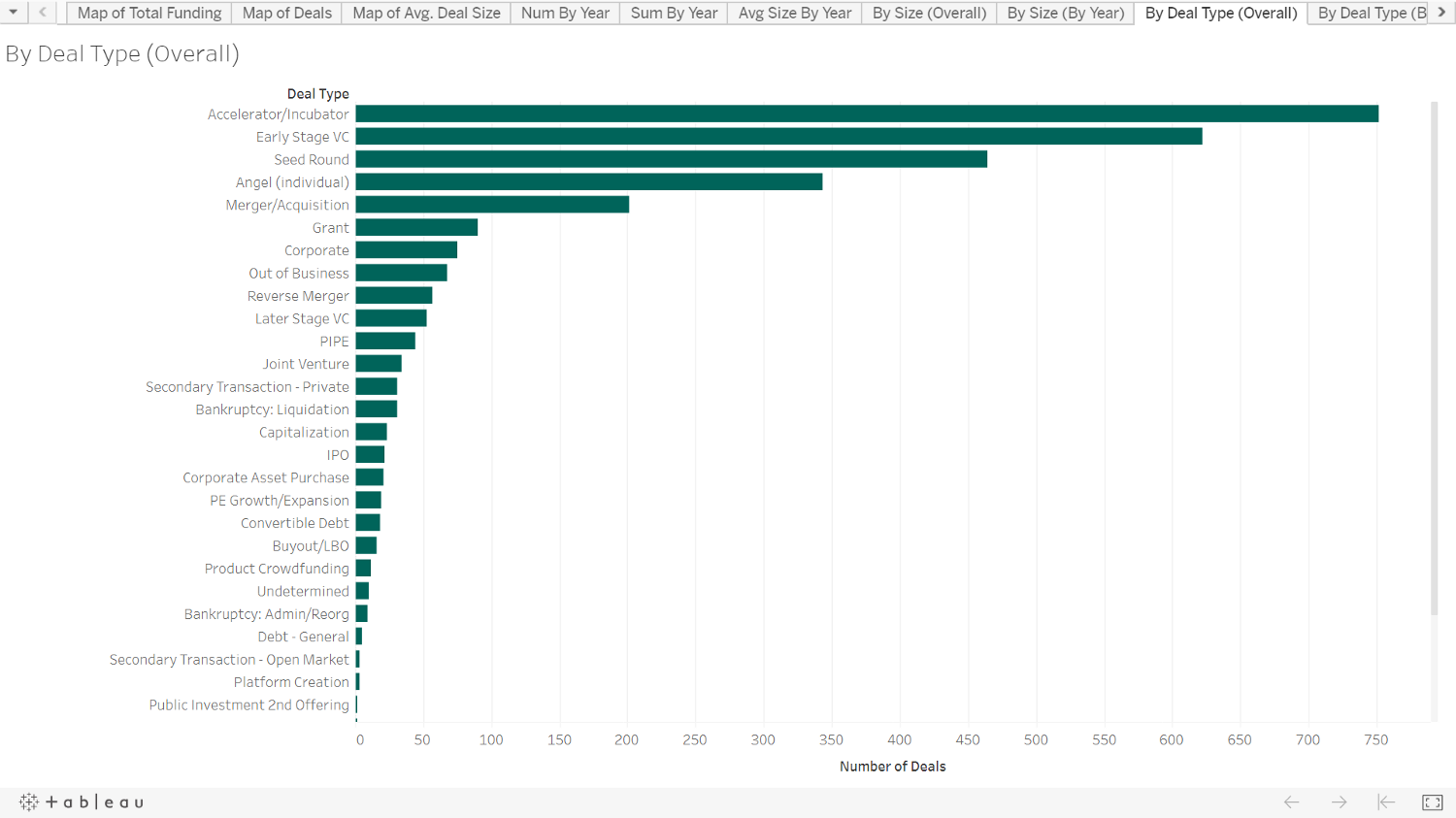
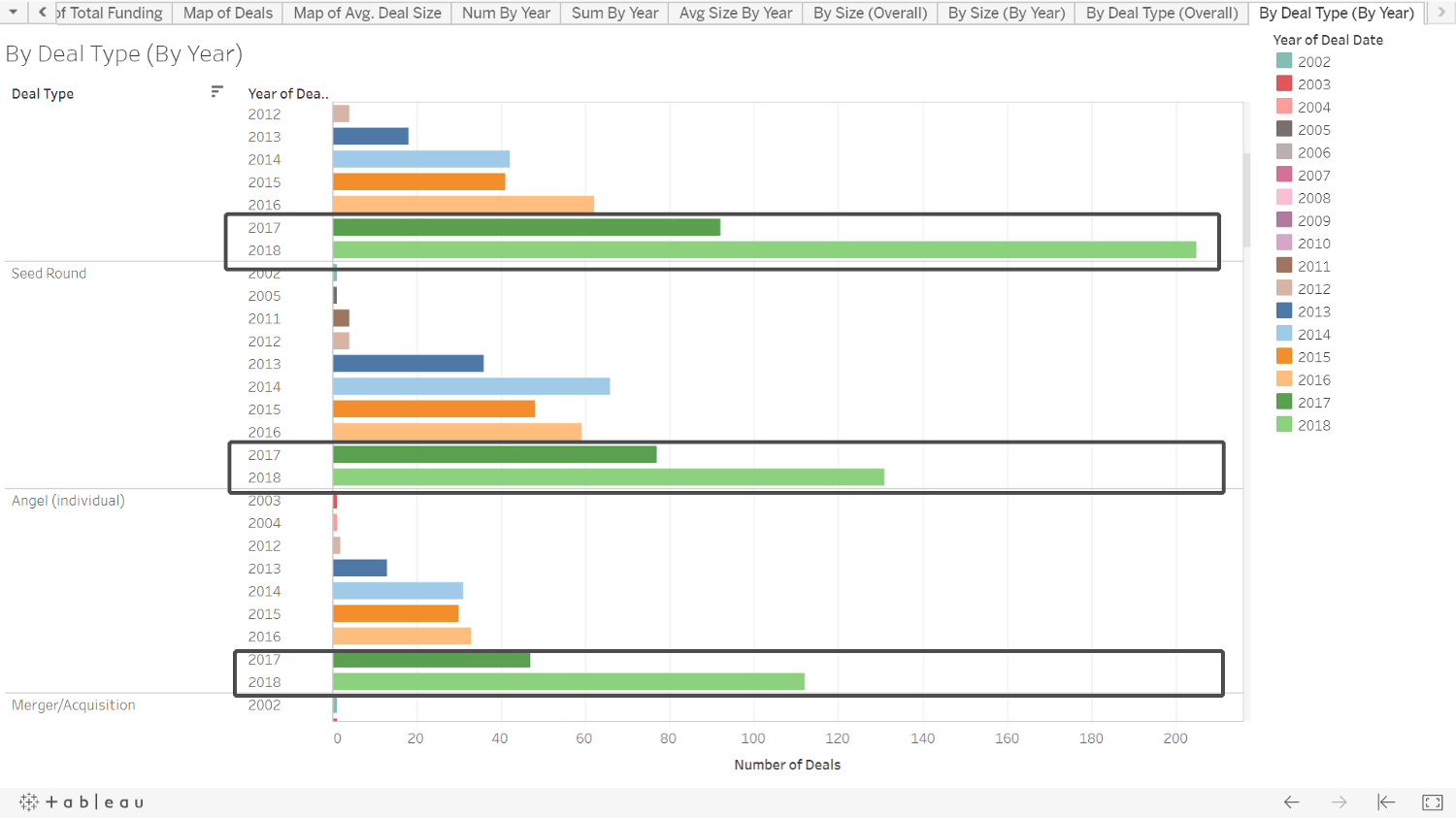
The number of M&A deals doubles in 2018. With more M&A deals such as CBIX acquired by Bitbuy and Tobit Clicks acquired by Protect Pharmaceutical, the number of M&A deals increases from 40 in 2017 to 91 in 2018. Of the 91 M&A deals in 2018, 40 happened in the US, 28 in Canada, 3 in UK, 3 in Japan, and the rest come from countries such as India, Hong Kong, and China.
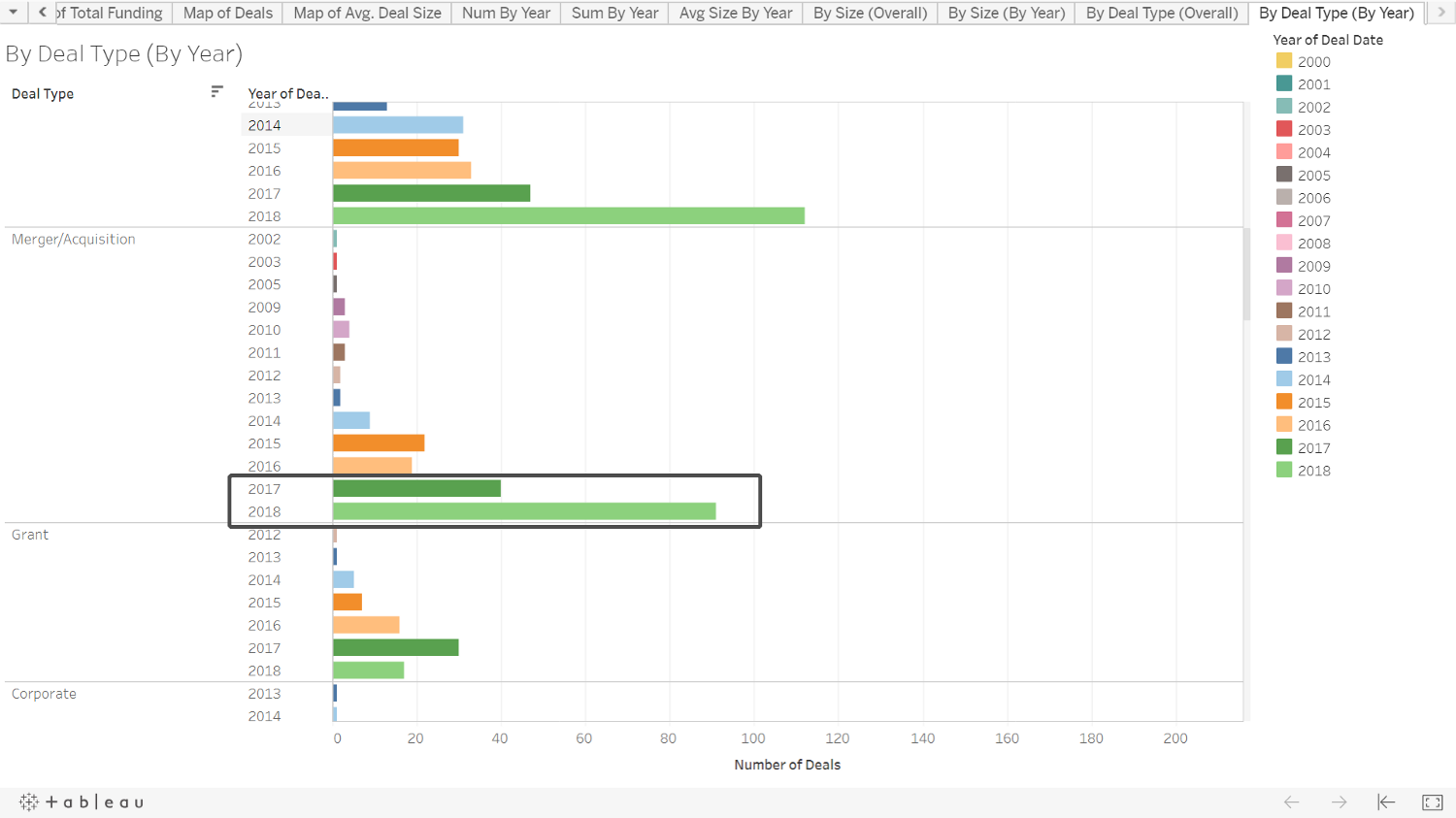
Traditional financial institutions/corporate companies have not been heavily involved in M&As yet. 35 (38.46%) of the M&A deals were made by public companies. While the only traditional financial institution on the list is EY, which acquired Elevated Consciousness in July, 2018. The other acquirers are blockchain/cryptocurrency companies themselves or tech companies such as GoDaddy and Rakuten.
See appendix for the full list of 91 blockchain M&A deals in 2018.
Buzzwords
With no doubt, since the invention of blockchain technology, most of the funding has flown to cryptocurrency-related start-ups (e.g. issuance, trading/exchange, mining, investment, crypto payment, etc.).
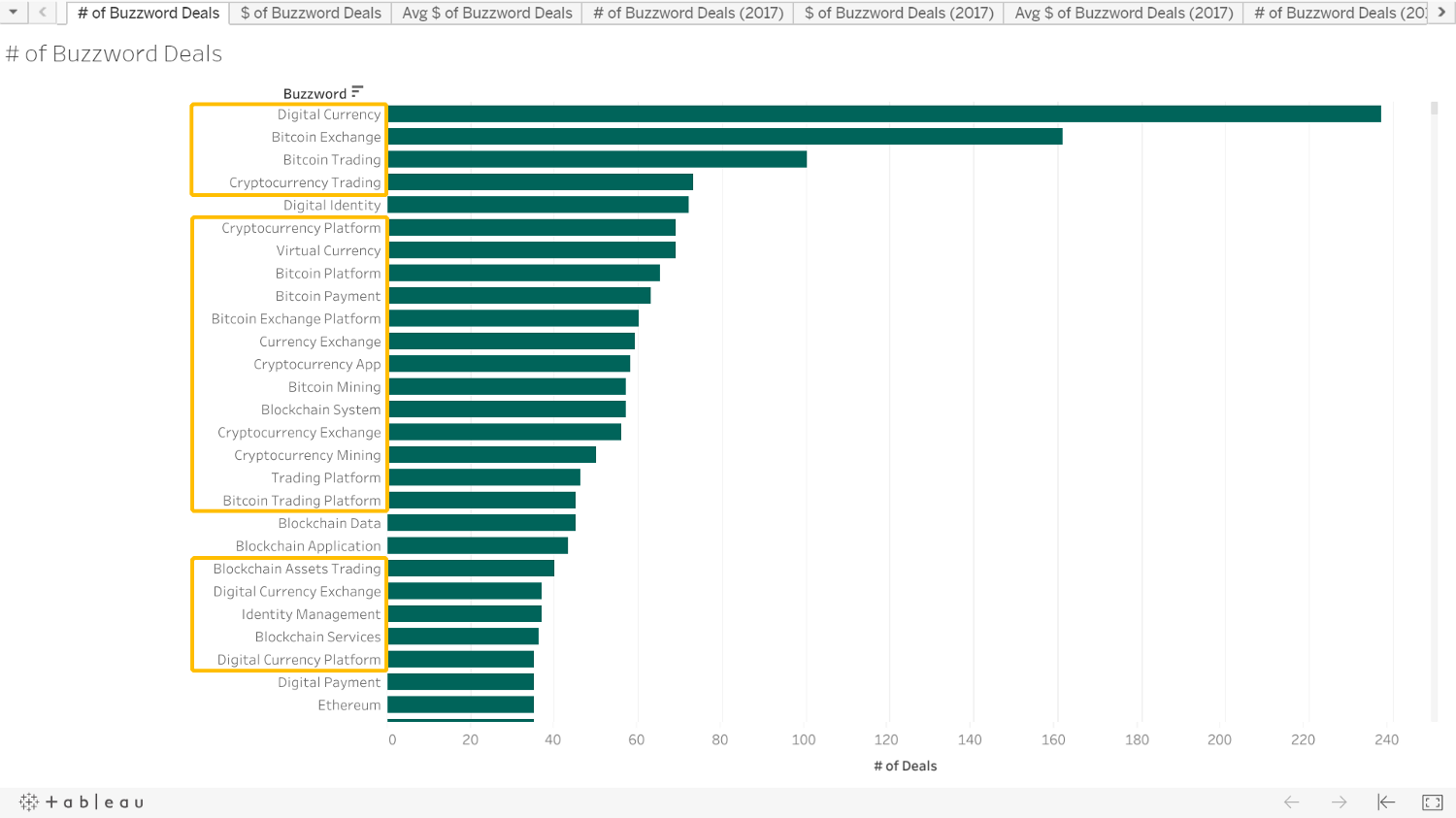
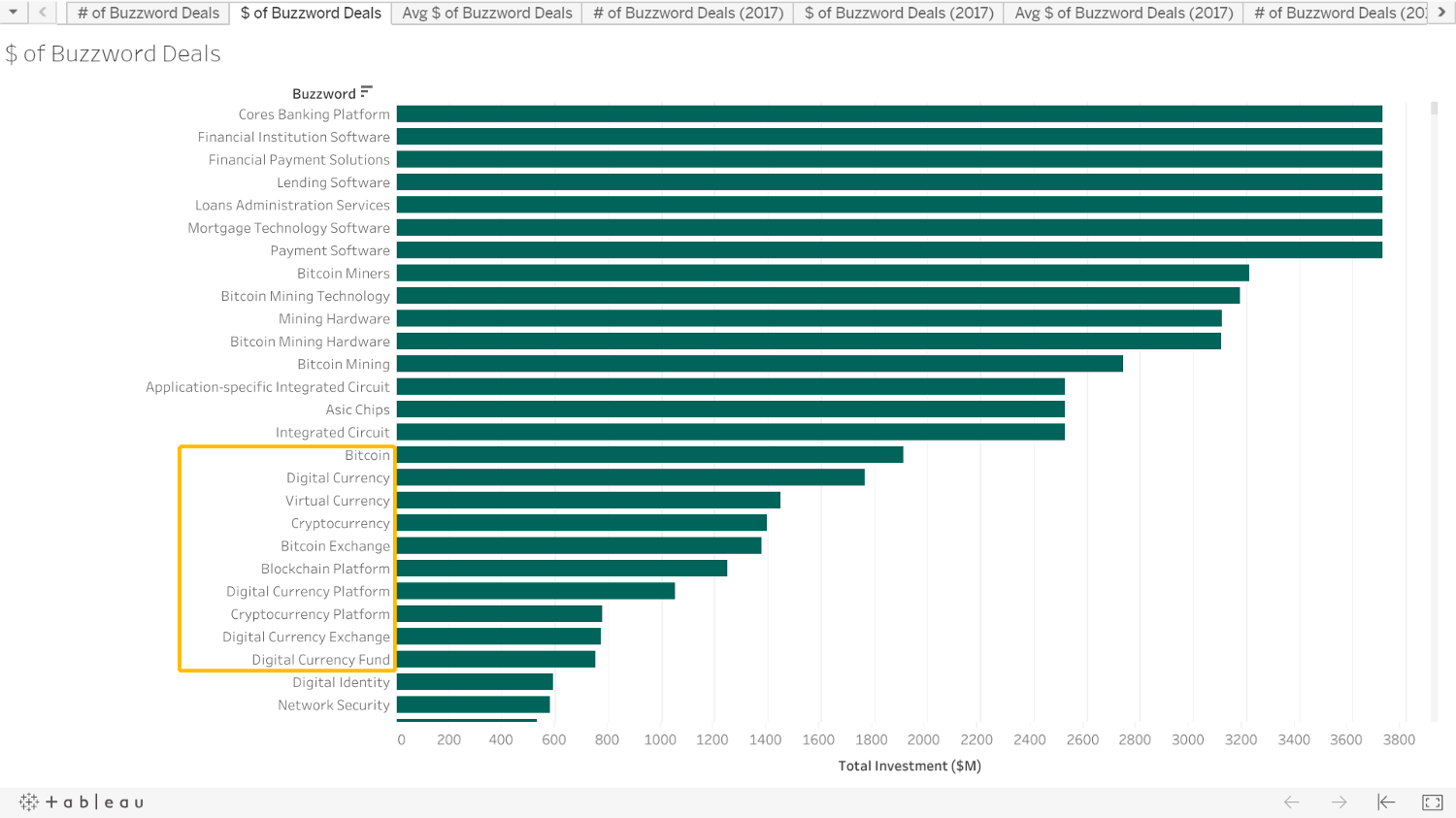
Two big deals (D+H acquisition and Bitmain IPO) have contributed to the abnormally high investment volume of some verticals in the graph above.
After excluding the cryptocurrency-related (including mining) buzzwords and the general words such as blockchain technology, we can see the most invested “buzzwords” in 2017 are: Blockchain Assets Trading, Digital Identity, Energy Storage System, Impact Investing Vertical, and Cyber Security. Following these buzzwords, some other verticals such as Enterprise Blockchain Platform, Fund Management Platform, and Invoice Financing have also attracted 4 to 5 deals in 2017. However, cryptocurrency-related investments are still the mainstream among the 547 deals closed in 2017.
In 2018, after excluding the cryptocurrency-related (including mining) buzzwords and the general words such as blockchain technology, we can see the most invested “buzzwords” in 2018 include: Blockchain Security, Crypto Assets & Exchange, Financial Software/Services, Stablecoin, and Blockchain Games/Gaming Platforms. Besides these buzzwords, we can also see that VCs are bringing a large portion of their money to blockchain-based Health Care Platforms, Blockchain News Portals, Consensus Algorithm Developers, Insurance Platforms, and Logistics Platforms. However, most of the deals are still concentrated in cryptocurrency-related start-ups.
Moreover, by examining the volume of investments into different buzzwords in 2018, we can further discover that Consensus Algorithm/Protocol Development, Stablecoins, and Cyber Security have attracted the most money. This is understandable since (1) there has not appeared a perfect consensus protocol yet, a fact that will affect the wide implementation of the technology; (2) even for the most basic application as an exchange medium, no cryptocurrency has been widely accepted due to the high volatility.
From 2017 to 2018, most of the investment growth goes to cryptocurrency-related start-ups, as expected. From the second graph below, we can see the new investment domains in 2018, which are quite similar to what we found in the above analysis, are primarily related to Cryptographic Technology (the base for security and protocol design), Stablecoins, and Assets Securitization/Management.
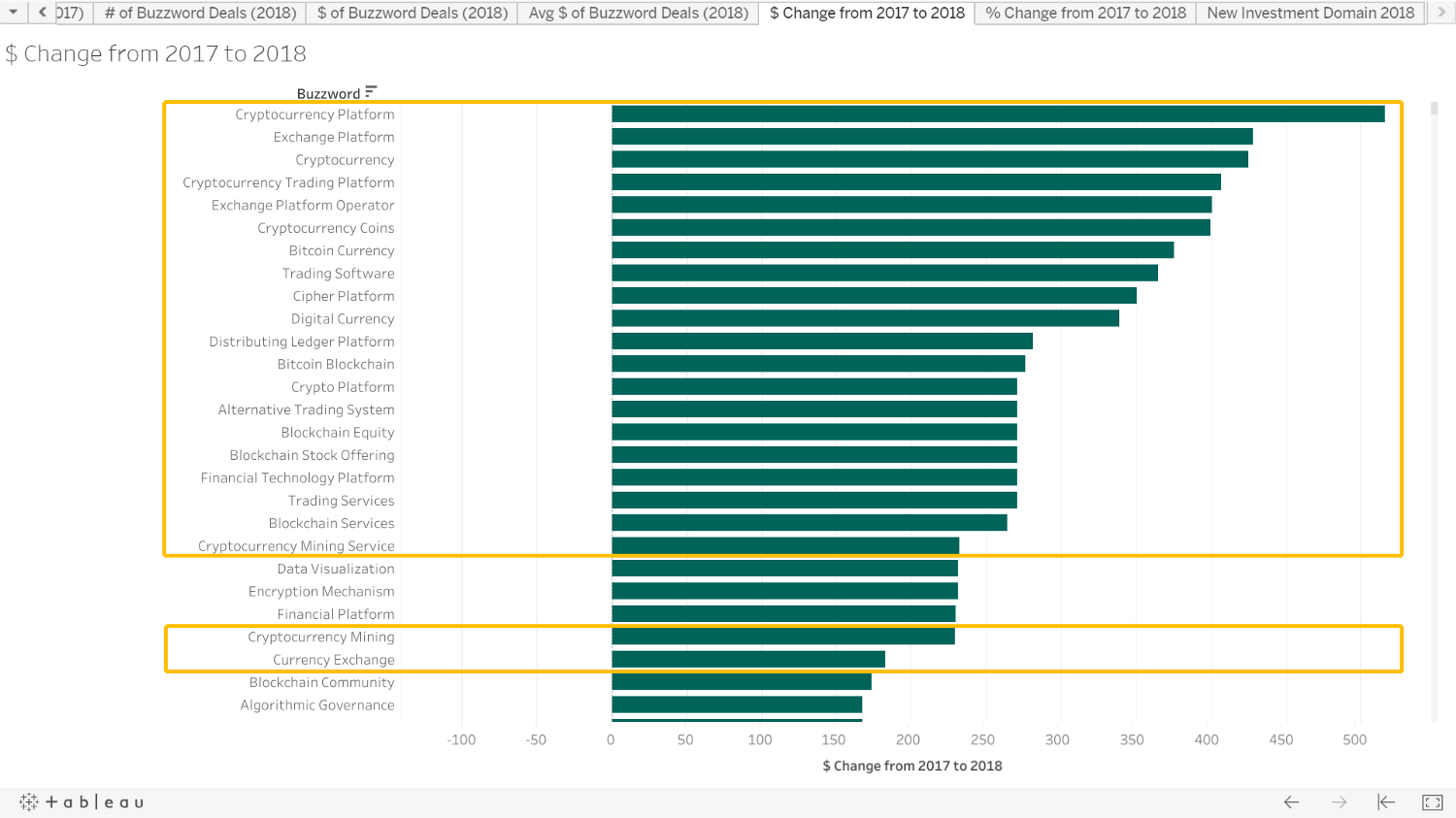
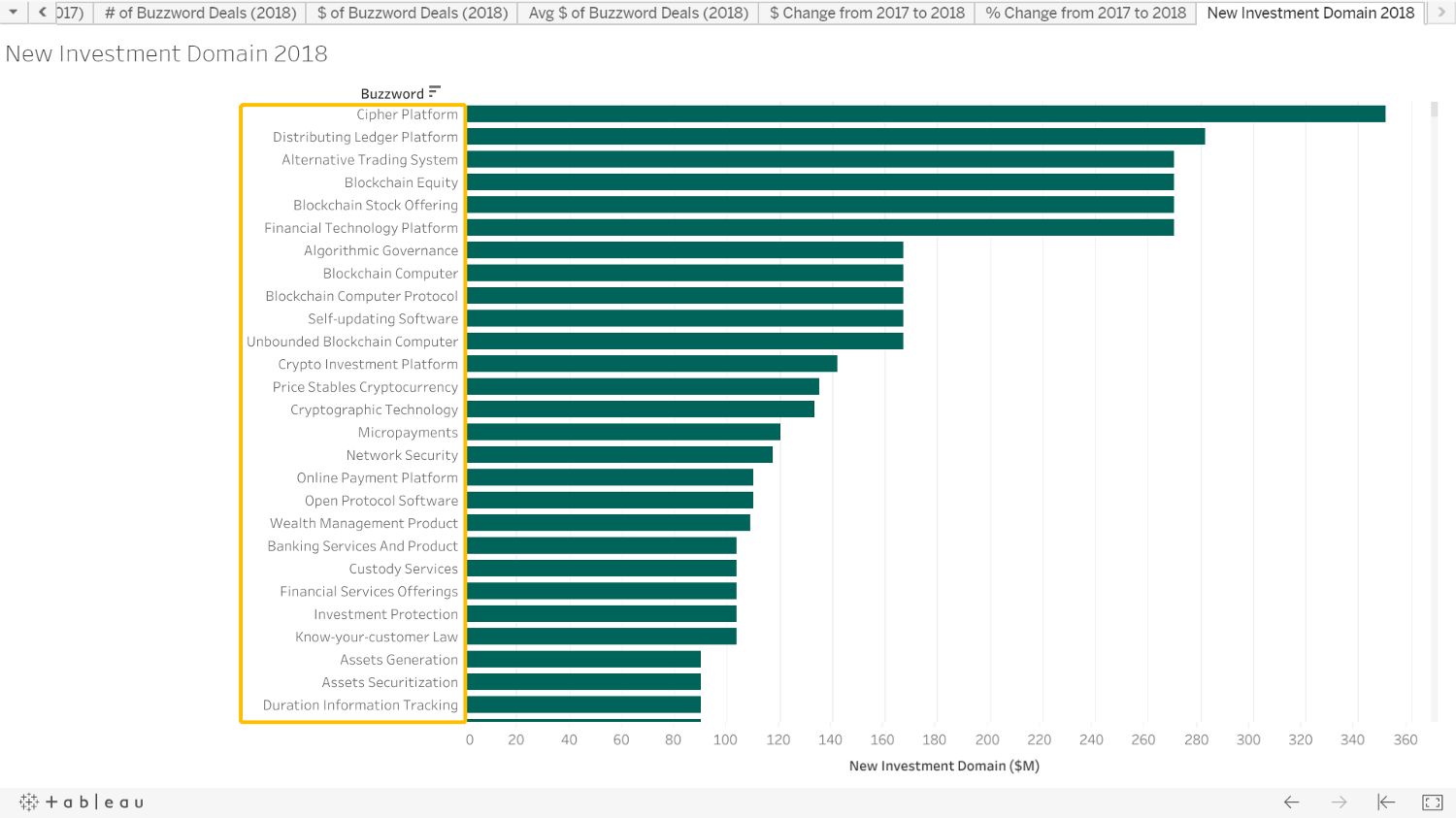
Conclusion
- 74.72% worldwide blockchain investments have been made in three markets: US (50.59%), China (17.05%), and Canada (7.08%). The US market has the biggest number of start-ups (933) and deals (1,330), while Chinese companies have the highest average valuation ($115.2 M) and deal size ($70.31 M), which indicates a high investment concentration.
- Blockchain investment has doubled from 2017 to 2018 with more funding goes into cryptocurrency-related start-ups, regardless of the poor performance of the cryptocurrency market. As of October 27, 2018, $10,680 M have been raised (including ongoing IPOs), while only $5,623 M were collected in 2017. A large portion of the new investment goes into cryptocurrency platforms.
- The most active investors are those exclusively dedicated to blockchain investments since there is a high knowledge barrier in understanding the technology.
- ~75% of the deals are early stage investments in the blockchain space. Out of the 3,035 recorded deals, 2,271 (74.83%) deals are early stage investment (Angel/Early Stage VC/Seed Round/Grant/Accelerator/Incubator).
- Technology integration is happening in the space. The number of M&A deals increases from 40 in 2017 to 91 in 2018. However, few of the deals were made by non-blockchain/traditional companies, indicating that the M&A deals are more about technology integration within the industry.
- As expected, most of the investment has been directed to cryptocurrency-related startups in 2017/18. These startups work around cryptocurrency issuance, exchange/trading, mining (hardware and software), wallet, payment, etc. The investment is still growing rapidly regardless of the poor performance of the cryptocurrency market.
- The most invested “buzzwords” in 2018 include: Blockchain Security, Crypto Assets & Exchange, Financial Software/Services, Stablecoin, and Blockchain Games/Gaming Platforms.
- New investments are primarily made into: Cryptographic Technology (the base for security and protocol design), Stablecoins, and Assets Securitization/Management. Particularly, Consensus Algorithm/Protocol Development has attracted a large portion of money. The reasons is that all existing protocols have some flaws in design, and therefore a “perfect” protocol is still needed.
This research project is completed through a collaboration between Fan Wen at Yale SOM and Josh Liggett at OurCrowd.
Disclaimer: The article is not, and should not be regarded as “investment advice” or as a “recommendation” regarding a course of action, including without limitation as those terms are used in any applicable law or regulation.
Appendix: a list of M&A deals in 2018
